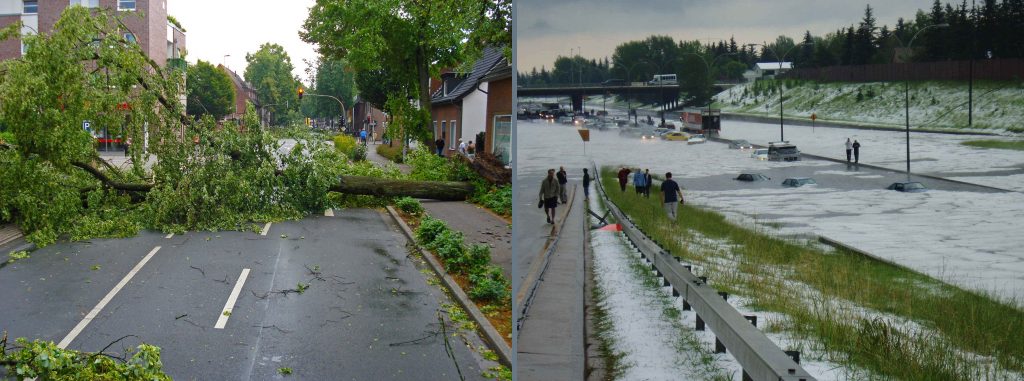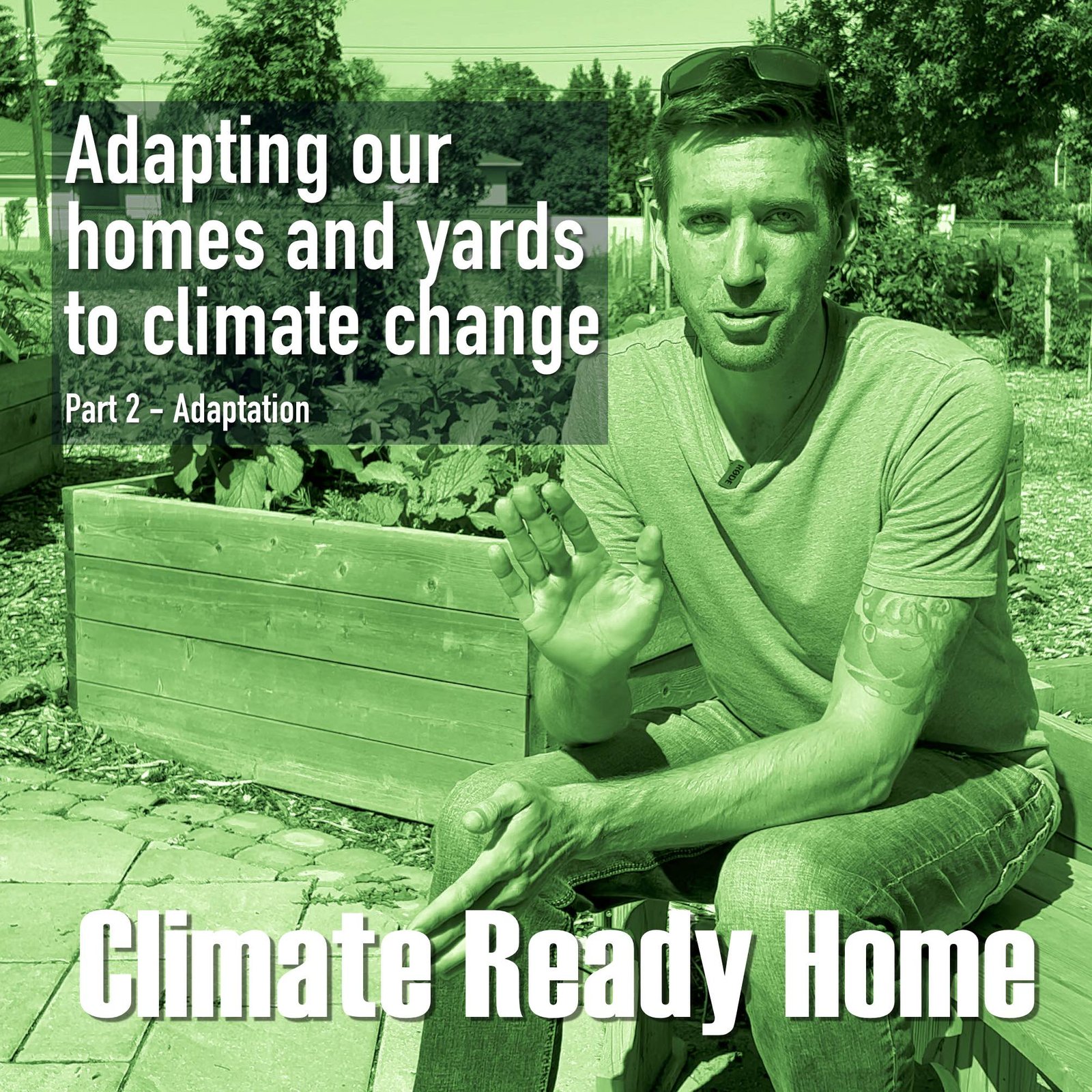Changing for Climate Series *
There are many things we can do to make our homes climate-resilient and better able to withstand the droughts, fires and crazy storms that seem to be all part of the new reality.
In our story Climate Ready Home Part 1 we learned about all the things we can do to reduce emissions and save energy in our homes. These efficiency measures such as insulation, heat pumps, and better windows all reduce energy use and emissions and are referred to as “climate mitigation.”
In this story we talk to sustainability teacher Kenton Zerbin about how we can adapt our homes and yards to the impacts of climate change we are already experiencing, a process referred to as “climate adaptation.”

The six big climate risks for Edmonton
Kenton says there are six main risks we face from a changing climate in order of importance for Edmonton:
- Floods – downpours of heavy rain and the resulting floods can wash away our home’s foundation, cause mould and mildew to proliferate, damage electronics, and more! We’ve seen very severe events in Calgary, High River, Fort McMurray and many other places.
- Heat – the heat dome event of 2021 brought record temperatures to our region. On June 29, 2021, more than two hundred people died in BC due to extreme heat. Events like this also affect our plants and yards.
- Wind – we are experiencing more frequent severe wind events that can bring down trees and damage our homes.
- Hail – hail can fall at speeds of 100 km/h or more and cause significant damage to homes, property, cars and crops.
- Drought – not only are we getting flooding events, there are also increasing periods of drought that can affect crops, our yards and city landscapes.
- Fire – wildfires are happening with increasing severity and have devastated cities like Fort McMurray, Slave Lake and Lytton B.C. In recent years, Edmonton has also suffered from extremely poor air quality numerous times due to high levels of smoke in the air.
Alberta has experienced five of the 10 most costly severe weather events in Canadian history. Check out Edmonton’s Climate Change Almanac to learn more about Edmonton’s Changing Climate and check out these resources on preparing for climate change.

A climate-resilient yard
Kenton Zerbin’s passion is creating sustainable landscapes in our yards that are resilient to climate change and offer many more benefits.
Many people have naturalized their yards to reduce the need for water and maintenance but Kenton says there is much more we can do.
“Growing a food forest is a fantastic method to source your food in a resilient way, sequester carbon, build soil and create a habitat for so many species, including yourself,” says Kenton.
Kenton has replaced lawns and created food forests at churches and he helped create the Waldorf Edible Food Forest and Community Garden in Edmonton. He says a good food forest mimics how a natural forest ecosystem works thus reducing maintenance and the need for water.

Growing local food also eliminates emissions from transportation and helps create food security. Groups are forming in community leagues to forage for food in Edmonton’s river valley in our series and there’s been a surge in interest in community gardening as well.
According to Kenton, there are three things you need to create and manage your naturalized yard or food forest: “…your garden, your compost pile, and your rain tank.”
There are many ways to integrate these into your home and neighbourhood.
There are some very innovative solutions. Kenton took us to the home of Dustin Bejar, a yard naturalization expert, where he showed us rain barrels that are shared by two neighbours.
Bejar also feeds the water from the eaves troughs on his home into weeping tile (a pipe with holes in it) that is buried in the yard to deal with run-off water and automatically water his alternative lawn, garden boxes and trees.
It’s a great idea to “harvest rainwater that’s free instead of sending it downstream to become a flood for someone else,” says Kenton. The alternative is “paying for [tap] water to come to your garden that’s chlorinated and kills the bacteria in your soil that your plants like.”
Use drought-resistant, native species where possible, hydrate with rain water when you can and reap the bounty of your own local food. Learn more here about Eco Landscaping with drought resistant plants and rain barrels.

Home Sweet Climate Resilient Home
There are many things you can do around the house to reduce emissions and get ready for the impacts of climate change:
- Consider a metal roof to help collect clean rainwater and protect yourself from fire and storms. Bonus: Metal roofs also make for easier installation of solar panels.
- Increase your home’s level of insulation to save energy and protect you from cold spells and heat waves.
- Install a heat pump that uses two to three times less energy to produce heat and reduce emissions. And the bonus here is heat pumps also provide up to 700% efficient air conditioning during those increasingly frequent heat events.
- Invest in a heat recovery ventilator, which becomes necessary as homes get more energy efficient and airtight. They provide tons of fresh air, recover up to more than 70% of the heat from your exhaust air and many can filter your air to protect you from forest fire smoke and other pollutants as well.
We covered many of these solutions and more in our Climate Ready Home Part 1 video and blog.
For two inspiring stories on people renovating their homes to dramatically improve energy efficiency on the pathway to net-zero check out these two stories.
For other great climate adaptation ideas check out Change Homes for Climate Guide (PDF) and the Climate Resilient Home Guide (PDF), both produced by the City of Edmonton.
We have barely scratched the surface of the possibilities here, but the good news is many of the things we can do to improve the energy efficiency of our homes (insulation and the installation of heat pumps for example) reduce emissions and they also protect us from the impacts of climate change that we are already experiencing.
*(David Dodge of Green Energy Futures worked with the City of Edmonton to produce a 14-part series on people Changing for Climate – we are pleased to present an adapted version of the original story here)

